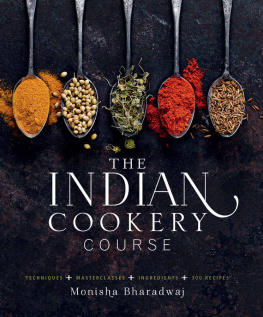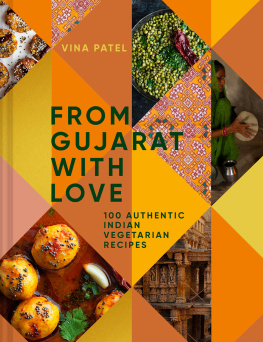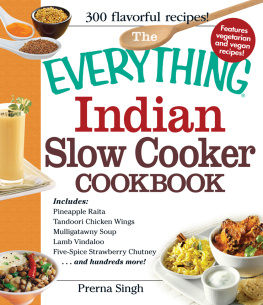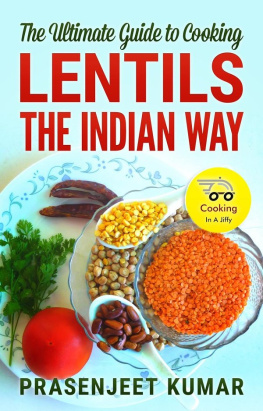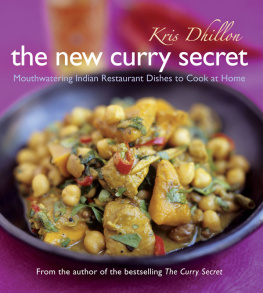

MONISHA BHARADWAJ is a qualified chef and an award-winning author. She was Guild of Food Writers Cookery Writer of the Year in 2003, Stylish Indian in Minutes won the Guild of Food Writers Cookery Book of the Year and The Indian Pantry won a prestigious silver medal at Germanys Deutschland Akademie ausgezeichnet. She runs a successful Indian cookery school in London called Cooking With Monisha (www.cookingwithmonisha.com) and teaches at some of the UKs top cookery schools. Monisha has been Guest Chef at Benares, a Michelin star restaurant in London and at the Intercontinental Hotel, Park Lane. She is often invited to judge food events such as the Great Taste Awards and has lectured at SOAS, University of London, about The History and Culture of India through its Food.
CONTENTS

HOW TO USE THIS EBOOK
Select one of the chapters from the and you will be taken to a list of all the recipes covered in that chapter.
Alternatively, jump to the to browse recipes by ingredient.
Look out for linked text (which is in blue) throughout the ebook that you can select to help you navigate between related recipes.
You can double tap images to increase their size. To return to the original view, just tap the cross in the top left-hand corner of the screen.

FOOD IS CENTRAL TO AN INDIAN PERSONS LIFE. IT IS SPOKEN ABOUT ALL THE TIME, IS A GREAT ICEBREAKER AND IS COOKED AND EATEN THROUGHOUT THE DAY. THE HIGHEST DEMONSTRATION OF LOVE IN INDIA IS TO FEED SOMEONE.
INTRODUCTION
I ndian food needs no introduction. Its rich, delicious flavours and enticing aroma of herbs and spices have tempted the most conservative palates and restaurants started by people from the Asian sub-continent have taken Indian food across the seas and made it available to a wide audience. Attention to detail, excellent chefs, clever packaging and marketing have ensured that people know more about it now than ever before.
I grew up in Mumbai when it was still called Bombay, amongst great lovers of food, then went on to train as a chef at the Institute of Hotel Management, Catering Technology and Applied Nutrition, commonly known as IHM, Mumbai. Every evening, Id be in the family kitchen trying out recipes by blending spices and practising techniques such as grating a coconut to make milk. Those were an intensely food-related three years and I loved the chance to be creative and learn about the diversity of a cuisine that had such a rich history and so much variety. Mumbai was and still is Indias commercial capital and therefore attracts people from all over the country. It was wonderful to taste a wide variety of regional Indian cuisines such as Sindhi, Gujarati, south Indian and Kashmiri, through friends, neighbours and speciality restaurants. I also tried a range of regional dishes on family holidays to almost every state of India. I remember eating Kerala fish molee as an eight-year-old and Rajasthani dal bati, a rich dough bread served with ghee and lentils, at ten. I still visit India a few times a year and go on food trips driving off the tourist track to visit market towns and villages that hold the secrets to good, wholesome, regional fare.
As a newly trained chef I came to England in the 1980s to study journalism. I had completed a degree in Indian History in India and wanted to find a way to combine my interests through writing about Indian food. I arrived from the warm sunshine of Bombay to a foggy February day in London. I knew that Id have to cook a spiced Indian meal to warm up and set off in search of the right ingredients. In those days, grocery shops still had very seasonal vegetables and all I could see were parsnips, swedes and Brussels sprouts. Not what I was used to at all! Thankfully, I could buy a cauliflower and made my first curry with a few spices that I had brought from India. I learnt that in order to buy a variety of Indian ingredients, Id have to go to an ethnic area and so made my way to Southall. Imagine my delight upon seeing coriander leaves, coconut and turmeric all ingredients that now, almost 30 years later, are seen in many supermarkets all over the UK.
There was an interest in Indian food in the UK at the time, but the recipes I found in books and magazines seemed complex, with long lists of ingredients and many steps to achieve an authentic Indian meal. My cooking was simpler, quicker and fuss-free. I started my cookery school in London Cooking With Monisha where I taught members of the public, chefs and students of hospitality management an easy, manageable style of Indian cooking. Cooking With Monisha is a vibrant school now and I also teach the Indian courses at several top cookery schools around the UK.
The Indian food that is available in the UK is only a small part of a very vast and diverse cuisine. This has to do with migration: people from northern India, mainly Punjab, Gujarat and Bangladesh (which was a part of India until 1947) brought their food to the West and adapted it to suit local tastes. Dishes were classified by heat hot vindaloo and mild korma and were named after cities that were important strongholds of the British Raj Bombay Aloo and Chicken Madras. Neither of these dishes can be found in India! Today, as more people travel to India from the West, there is an appreciation of what lies beyond the samosa and the jalfrezi.
In this book, I have recreated a cookery masterclass at my school. Id like you to consider this a personal one-to-one lesson with me standing in your kitchen, guiding you with tips and hints as we create the perfect Indian meal. The step-by-step photographs will give you an idea of technique and texture as well as the different stages of the dishes. Please bear in mind that you can personalise the recipes by adding more or less chilli, seasoning or oil.
An increasing number of people are now cooking Indian food at home. Although jarred curry sauces are available in supermarkets, home cooks have realised that they are often too greasy, overly spiced and full of salt; nowhere close to the real thing. Cookery schools all over the world now offer Indian courses and the interest in learning not just how to use spices, but also regional Indian cooking, is increasing. People who come to my cookery school now talk about Keralan curries or a Bengali pineapple chutney that they have eaten on visits to India. Many tourists have been to Rajasthan and had a thali, where lots of dishes are served all together in small bowls, or to Delhi where theyve discovered the joys of richly spiced, Mughal curries such as Butter Chicken.
Food is central to an Indian persons life. It is spoken about all the time, is a great icebreaker and is cooked and eaten throughout the day. The highest demonstration of love in India is to feed someone and one of the first questions older members of an Indian family ask the younger ones who are away from home is have you eaten? Recipes are traditionally passed down from mother to daughter. However, more and more Indian men are now seen in the kitchen, especially outside of India. As people travel and TV shows bring India to living rooms the world over, Indian cookery is receiving attention from newer and evermore curious audiences.
Next page
